Acer Aspire S5 Ultrabook Review: The Steady March of Progress
by Dustin Sklavos on July 9, 2012 7:40 PM ESTBattery Life
Acer's Aspire S5 just doesn't have enough space inside for Acer to load up on battery capacity the way HP did with their Folio 13. Acer only rates it for 6.5 hours of running time. That being said, it performed remarkably well given its battery capacity:
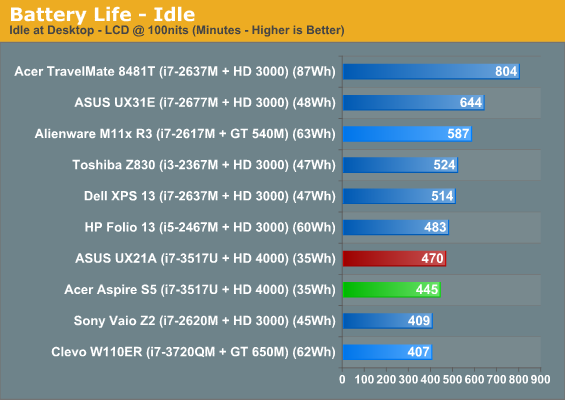
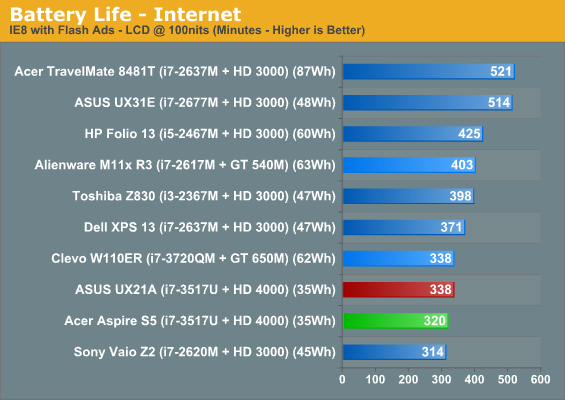
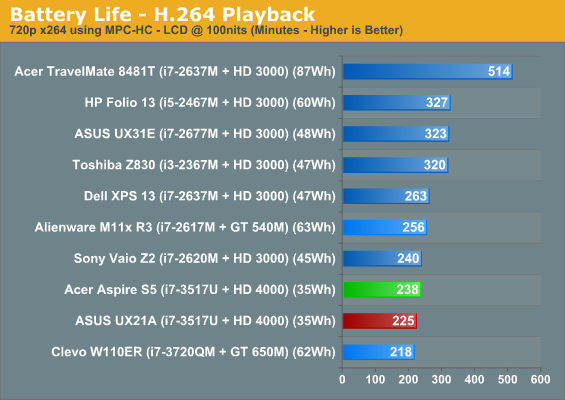
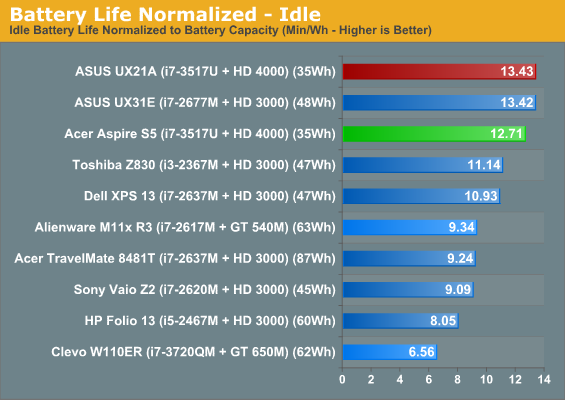

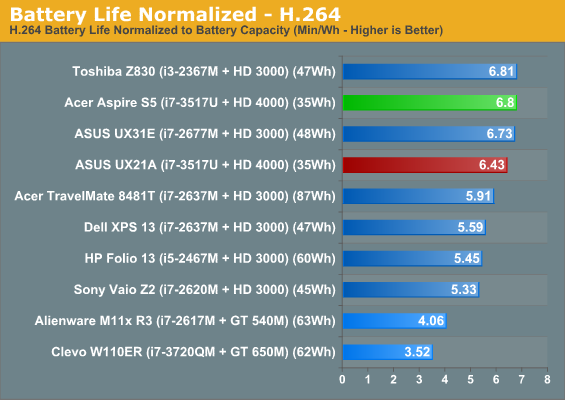
As it turns out, Acer's battery life estimate is mostly on the money and in fact can even be beaten in the right circumstances. Despite having a relatively small capacity, the Aspire S5 is still able to run for more than six useful hours. It's worth noting that overall, Ivy Bridge does seem to be able to produce better battery life efficiency as a whole than Sandy Bridge, and that's the kind of progress we can all appreciate.
Noise and Heat
Like most ultrabooks, the Acer Aspire S5 can get a bit noisy at load. What's important to note, though, is that at idle and low load, the fan is basically silent. The pitch of the fan noise is also relatively low; there's definitely the sound of air moving, but the noise is relatively tolerable compared to how high pitched these small fans can often get.

These thermals might look a little toasty, but they're actually among the best I've yet seen in an ultrabook. Acer has successfully implemented a remarkably efficient cooling system, and best of all, they've been able to do so without introducing any ventilation to the bottom of the notebook. Well done.
Screen Quality
Unfortunately, while the Aspire S5 is so far a pretty solid proposition from Acer, it falls flat on its face when it comes to display quality. The glossy finish on the S5 isn't as aggressive as I'm used to seeing, but that's about the nicest thing I can say about it. It's extremely disappointing that Acer isn't willing to bring the display up to par with the rest of the notebook.
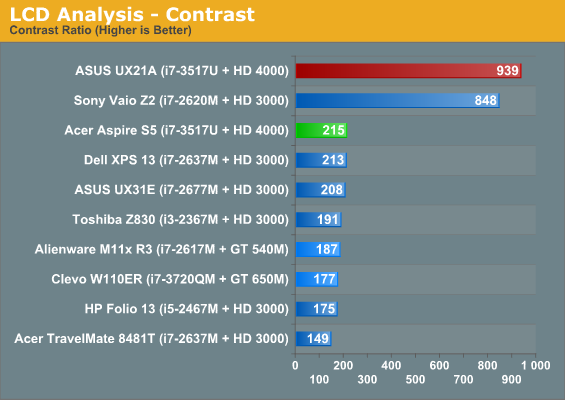


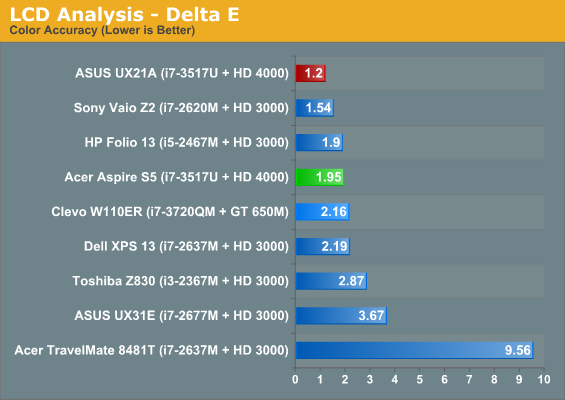
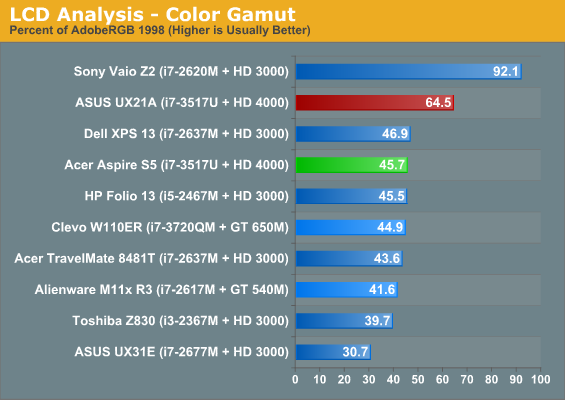

Display quality on most of these ultrabooks is just absolutely dire. If you look at the results of the ASUS Zenbook Prime UX21A, you can get a good idea of where the future lies, and it's not with shoddy panels like this one. Charging $1,399 for an ultrabook with this low quality of a panel is embarassing.










82 Comments
View All Comments
magreen - Tuesday, July 10, 2012 - link
agree 100%.anyone for going back to the Atari 2600's 160x192 5:6 resolution for the next premium laptop?
seapeople - Tuesday, July 10, 2012 - link
The next step for Asus is to cut out the USB 3.0 and include USB 1.1 instead and subsequently cut the laptop price from $1400 to $1397.Mumrik - Wednesday, July 11, 2012 - link
You mean Acer I hope...frakkel - Tuesday, July 10, 2012 - link
Completely agree that the screen is an important factor. But as far as I have understood Anandtech first calibrate the screens before comparing to each other. How many ordinary people does this?To have a 200 dollar screen that is not calibrated is in my opinion the same deal braker as havíng a 50 dollar screen which is also not calibrated.
As long as you have to do the calibration by your self it simple does nok make that much of a difference if the manucture put in a 200 or a 50 dollar screen. The color accuracy of a non calibrated 200 dollar screen is still terrible. And since most people dont do the calibration I understand why Acer put in thís mediocre screen.
Impulses - Tuesday, July 10, 2012 - link
Color accuracy is the worst of their problems... ASUS' UX31 is cheaper and has a higher res 1080p display that gives you a larger work space. Not only that, its an IPS display with superb viewing angles that dont wash the display out when viewed off center, and like when the guy in the plane seat in front of you decides to recline all the way and your own seat is busted.Impulses - Tuesday, July 10, 2012 - link
The least of their problems rather...JarredWalton - Tuesday, July 10, 2012 - link
Not to mention the contrast. Your brain will basically interpolate so that even if the color accuracy is off, it's "okay" for most people (look at all the tablets that are >10 dE and have no way to calibrate, and some are 50+ dE). For laptops, I think the relative cheapness of the display is easy to determine by looking at where it falls in the following list. (Note that matte vs. glossy is essentially a separate issue; you can have bad matte screens just as easily as bad glossy screens, though I continue to prefer matte over glossy.)[Worst]
Low contrast, low resolution (DPI)
Low contrast, higher resolution (DPI)
High contrast, lower DPI
High contrast, higher DPI
High contrast, higher DPI, better color gamut
High contrast, higher DPI, better color gamut, non-TN
[Best]
Generally speaking, there really aren't any non-TN displays with good characteristics that are still low-resolution, which is good as the last thing we need is 1366x768 IPS displays shoved into 13.3" and larger laptops.
Steveymoo - Tuesday, July 10, 2012 - link
I mean, seriously? They're so damned expensive for what they are!!They're under-performing, 99% of them have terrible screens, and the only practical use I can think of for them, is general office productivity, and internet browsing... Sure they do that pretty well, but why would a company pay over the odds for what is essentially a collection of cheap components, in an expensive (albeit slim,) package.
mrdude - Tuesday, July 10, 2012 - link
It seems that every time I read an ultrabook review I see the same things being uttered: crappy display, not-so-great battery life, too expensive and way way too hot. The form factor is far too thin given the heat output of the processors at 17W TDP and that's not going to change as Haswell will have the same TDP. The components themselves cost more due to the nature of the design and the margins for ultrabook makers is actually below 7%! No wonder the displays are so damn crappy. Even given that super inflated price tag, Acer is almost certainly penny-pinching to barely break even.Why in the world would I want one? Why in the world is Intel pushing these? You can grab a Toshiba Portege with an equally crappy display and have none of the heat issues, better battery life, swappable components, much better performance and all this at the same weight as an ultrabook. The TimelineU M5 seems like a much better format considering the size but even for that thick a laptop (compared to this), Acer had to use a ULV i5 rather than a regular 35W chip and even that laptop suffers from heat and throttling issues (an important point that gets overlooked in every Anandtech review... Can you guys please start checking for throttling during gaming and heavy CPU/GPU work?)
Something needs to change. Either Intel needs to loosen the requirements or tighten them even further. As I see ultrabooks today, they're stuck in some sort of halfway super-portable laptop that just doesn't make sense given the drawbacks and the just-as-portable-but-not-crappy alternatives.
Impulses - Tuesday, July 10, 2012 - link
So you skipped both Zenbook articles?